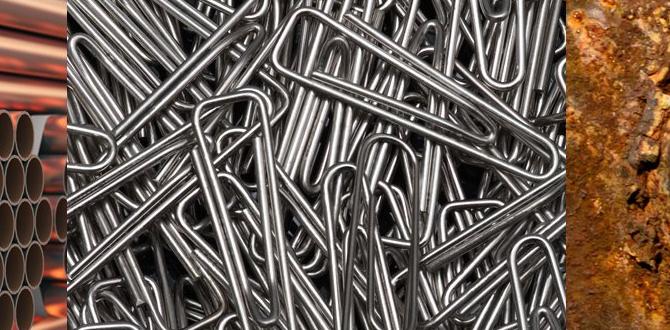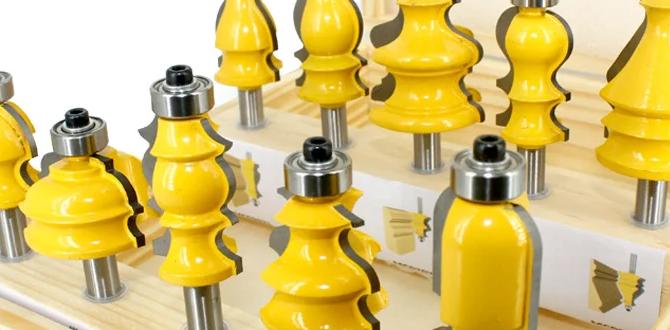Quick Summary:
A mini wood lathe sanding system makes finishing projects smooth and easy. Learn simple techniques for perfect results every time, turning frustrating sanding into a satisfying part of your woodworking!
Hey everyone, Daniel Bates here from Lathe Hub! Ever feel like sanding is the most tedious part of using your mini wood lathe? You’ve spent hours creating a beautiful shape, only to dread the final finishing. Let’s be honest, getting a perfectly smooth finish can be challenging. But what if I told you there are tried-and-true ways to make your mini wood lathe sanding system work effortlessly? Today, we’re diving into proven tips and tricks that will change how you approach sanding. Get ready to achieve that glass-like finish without the headache!
We’ll cover everything from choosing the right abrasives to mastering techniques that save you time and effort. Stick around, and you’ll be amazed at how simple sanding can become!
Understanding Your Mini Wood Lathe Sanding System
Before we jump into the “how-to,” let’s quickly touch on what makes up a mini wood lathe sanding system. At its core, it’s about using your lathe’s rotation to evenly apply sandpaper to your workpiece. This is often done in a few ways:
- Direct Sanding: Holding sandpaper directly against the spinning wood.
- Sanding Blocks/Pads: Using a holder for the sandpaper to get a more consistent pressure.
- Specialized Sanding Tools: Tools designed specifically for lathe sanding, like spindle sanders or drum sanders that might attach to your lathe.
The beauty of a mini wood lathe is its precision. When you harness that for sanding, wonderful things happen. The key is to use the lathe’s speed to your advantage, not fight against it. We want a system that’s efficient, safe, and delivers professional results, even if you’re just starting out.
Essential Tools and Materials for Effortless Sanding
To create an effective mini wood lathe sanding system, you’ll need a few key items. Don’t worry; most woodworkers already have some of these, and the rest are inexpensive investments that pay off quickly in better finishes and less frustration.
The Sandpaper Lineup
Sandpaper grit is everything! Think of it like a countdown from coarse to fine. You start with rougher grits to remove tool marks and shape, then move to finer grits for smoothness.
- Coarse Grits (60-100): For removing significant imperfections, like chatter marks or deep scratches.
- Medium Grits (120-180): The workhorses for smoothing out the results of coarse grits and preparing for finer sanding.
- Fine Grits (220-320): These start to bring out the smoothness and prepare the wood for finishes.
- Very Fine Grits (400+): For that showroom polish and to ensure finishes adhere perfectly.
For mini wood lathes, look for sandpaper that’s easy to handle and cut to size. Sandpaper rolls or pre-cut sheets are usually best.
Sanding Aids: Your Best Friends
While you can hold sandpaper by hand, it’s often inconsistent. Sanding aids offer better control and more even pressure.
- Sanding Blocks: Small, often rubber or wooden blocks that you wrap sandpaper around. These are great for flat areas or subtle curves.
- Sanding Pads/Buffers: These are typically foam or rubber pads that attach to a drill or even your lathe spindle. They distribute pressure more evenly than just your fingers.
- Stick-on Discs: For specific sanding attachments that use adhesive-backed sandpaper discs.
Dust Management: Safety First!
Sanding creates a lot of dust. A good dust collection system or a quality dust mask is crucial for your health. Keeping your workspace clean also makes sanding easier and safer.
Did you know that wood dust can be a respiratory irritant? The Occupational Safety and Health Administration (OSHA) provides guidelines on controlling wood dust exposure. Investing in a dust mask or a shop vac with a good filter is a smart move for any workshop.
Proven Techniques for Effortless Mini Wood Lathe Sanding
Now, let’s get to the good stuff! Here are the techniques that will make your sanding process smooth as silk.
1. Start with the Right Tool and Speed
The lathe’s speed is your ally. Generally, you want to sand at a slower speed than you cut. This gives you more control and prevents the sandpaper from burning the wood or creating deep scratches.
For most sanding on a mini wood lathe, a speed between 500-1000 RPM is a good starting point. This can vary based on the size and shape of your piece, but slower is often better when first learning.
2. Always Sand with the Grain
This is fundamental woodworking. Sandpaper removes wood. If you sand across the grain, you’ll leave noticeable scratches that are very difficult to remove later. Always move your sandpaper parallel to the direction of the wood grain.
3. Don’t Skip Grits!
This is where beginners often try to save time, and it backfires. Moving from a coarse grit (like 80) directly to a fine grit (like 220) will leave the deeper scratches from the 80-grit paper visible under the fine grit. You need to go through each intermediate grit (e.g., 120, 180) to remove the scratches from the previous stage.
Think of it like this: Each grit cleans up the mess left by the one before it.
4. Sand on the “Catch”
This is a slightly more advanced but incredibly effective technique. When the wood is spinning towards you (not away), the sandpaper has a tendency to “catch” the wood fibers. This can lead to more aggressive sanding and potential issues if not controlled. Often, it’s safer and smoother to sand as the wood spins away from you.
However, for some challenging spots or when using a powered sanding attachment, there are times you might sand on the catch. Always be mindful of the direction the wood is spinning relative to your hand or sanding tool. If using a tool, make sure it’s moving into the spinning workpiece, not being pulled back suddenly.
5. Power Sanding Techniques
Using powered sanding components can dramatically speed up the process and provide a more consistent finish.
- For Spindle Sanders/Drum Sanders: These attach to your lathe and essentially become a rotating sanding drum or disc. You simply bring your workpiece gently into contact with the rotating abrasive surface. Keep the workpiece moving to avoid creating flat spots.
- For Rotating Sanding Pads (Drill Attachment Style): These often attach to your lathe chuck or tailstock. You wrap sandpaper around them. Again, keep the pad moving across the workpiece and don’t let it “dig in.”
Always remember to wear eye protection and a dust mask when using power sanding tools. Wood dust can carry microscopic particles that are harmful if inhaled.
6. The “Stop and Go” Method
Don’t just hold sandpaper in one spot. This will create an uneven surface. Move the sandpaper smoothly along the length of your turning. For larger projects, you might divide the surface into sections and sand each section systematically.
When you reach the end of a section, gently lift the sandpaper off the wood as it continues to spin. Overlap your sanding strokes, just like you would when painting a wall.
7. Remove the Piece to Check Your Work
Periodically, turn off the lathe and feel your workpiece. Then, turn it back on and continue sanding. This reassures you that you’re getting a consistent finish and helps you avoid missing spots.
A quick visual check with a good light can also reveal imperfections you might not feel. Sometimes, dust can hide issues until you wipe it clean.
8. Final Sanding – The Polish
Once you’ve worked through your grits up to 220 or 320, it’s time for the final polish. If you plan to apply a finish like oil or lacquer, many experts recommend stopping at 320 or 400-grit. Higher grits can sometimes “burnish” the wood, making it harder for finishes to penetrate.
For an extra-smooth feel, you can use specialized sanding materials like abrasive-impregnated fibers or even very fine grit micro-mesh cloths. These are used at very high speeds, sometimes even turning the lathe off and moving the abrasive by hand as the piece coasts to a stop.
Table: Grit Progression Guide for Mini Wood Lathes
Here’s a handy table to help you navigate sandpaper grits for common projects. Remember, this is a general guide, and you might need to adjust based on the wood type and initial condition of your piece.
| Stage | Purpose | Typical Grit Range | Notes |
|---|---|---|---|
| Initial Shaping/Roughness Removal | Remove tool marks, minor blemishes | 60 – 100 | Use sparingly, only if needed. Can leave deep scratches. |
| Primary Smoothing | Remove coarse grit marks, prepare for finer grits | 120 – 150 | Ensure all marks from previous grit are gone. |
| Secondary Smoothing | Further refine surface, remove medium grit marks | 180 – 220 | Getting close to a finished feel. |
| Pre-Finish Sanding | Final smoothing before applying finish | 240 – 320 | Often the last grit before finish, depending on the finish type. |
| High-Gloss Polish (Optional) | Achieve a very smooth, almost lacquer-like feel before finish | 400 – 1000+ | Can sometimes make finishes NOT penetrate well. Use with caution. |
Troubleshooting Common Sanding Issues
Even with the best tips, you might run into a snag. Here are a few common problems and how to fix them.
Issue: Deep Scratches or Chatter Marks
Cause: Skipping grits, too much pressure, or inconsistent lathe speed.
Solution: Go back to an earlier grit (e.g., if you see 120-grit marks but were at 220, go back to 120 or 150). Ensure your tool rest is stable and your lathe speed is consistent. Reduce pressure on the sandpaper.
Issue: Sandpaper Burning or Gumming Up
Cause: Lathe speed is too high, holding sandpaper in one spot for too long, or working with very soft/resinous wood.
Solution: Reduce lathe speed. Keep the sandpaper moving constantly across the workpiece. For gummy woods, try using finer grits more often, or occasionally clean or replace your sandpaper.
Issue: Uneven Finish / “Tiger Stripes”
Cause: Inconsistent pressure, not sanding long enough with each grit, or using a worn-out piece of sandpaper.
Solution: Be methodical. Sand the entire surface evenly with each grit before moving to the next. Ensure your sandpaper is fresh and the pressure is consistent, whether using your hand or a sanding block.
Issue: Dust Gets Everywhere
Cause: Lack of dust collection or ventilation.
Solution: Use a dust mask always. If possible, use a shop vac with a dust collection attachment near the lathe. Wear old clothes that can be washed or dedicated shop attire. Consider an air filter for your workshop space.
Advanced Tips for a Superior Finish
Once you’ve mastered the basics, a few advanced techniques can take your mini wood lathe sanding to the next level. These are about refinement and achieving that professional touch.
1. Using a Stabilized Workpiece
For extremely fine sanding or polishing, you might want to advance your lathe speed. However, this can be risky with unbalanced or green wood. If your workpiece is stable (meaning dry and well-balanced), you can often increase your lathe speed slightly for the final sanding stages. Some woodturners even turn the lathe off and use very fine abrasives (like micro-mesh) to sand as the piece coasts to a stop, creating a beautifully burnished surface.
Always prioritize safety. If your workpiece wobbles or feels unstable, reduce the speed immediately. A wobbling workpiece can be dangerous and lead to poor results.
2. Abrasive Cord and Wheels
For intricate details or areas that are hard to reach with flat sandpaper, abrasive cords or specialized abrasive wheels can be invaluable. These can be used with your lathe to gently shape and smooth curves and coves. They require a delicate touch and are best used at lower speeds.
3. The Power of “Breaking” the Grit
New sandpaper can sometimes be too aggressive. Some experienced woodturners will “break in” their sandpaper before using it. This can involve lightly sanding the paper against a flat surface (like a workbench) for a few seconds, or even running it on a scrap piece of wood at a low speed.
Another technique is to apply a light coat of paste wax to your sandpaper before using it on the wood. This can help the grit glide more smoothly and reduce the chance of burning.
4. Using Finishes as a Sanding Aid
This is a neat trick many woodturners use. After sanding with your final grit (say, 320), you can apply a very thin coat of a sanding sealer or even mineral oil. While the finish is still slightly wet, you might take a piece of 400 or 600-grit sandpaper (or even finer) and lightly sand the surface. This creates a slurry that fills the wood pores and very gently polishes the surface. Wipe off any excess, let it dry, and you’ll often find an incredibly smooth finish.
This method works best with certain types of finishes and on woods that don’t have open pores that will clog too easily. Always test this technique on a scrap piece first.
Comparing Sanding Methods: A Quick Look
Let’s quickly compare some common methods used during the sanding process on a mini wood lathe.
| Method | Pros | Cons | Best For |
|---|---|---|---|
| Hand Sanding (with/without block) | Simple, inexpensive, good control for small areas | Can be uneven, tiring, inconsistent pressure | Small projects, touch-ups, final smoothing |
| Powered Sanding Pads/Attachments | Consistent pressure, faster than hand sanding, good for larger areas | Requires attachment, need to manage dust, can overheat if not used correctly | Bowls, spindles, larger forms |
| Special Spindle/Drum Sanders | Very efficient, consistent finish, can handle curves well | More expensive, requires specific attachments, can remove material quickly | Consistent curves, spindle work, faster material removal |
Conclusion
Mastering the mini wood lathe sanding system transforms a dreaded chore into a rewarding part of the creative process. By understanding your tools, progressing through your grits methodically, and employing these proven techniques, you’ll be well on your way to achieving those smooth, professional-looking finishes you’ve admired.
Remember, patience and practice are key. Don’t be afraid to experiment with different grits and methods on scrap pieces to find what works best for you and your projects. With these effortless tips, your mini wood lathe will help you turn out beautifully finished pieces every time. Happy turning and happy sanding!
Frequently Asked Questions (FAQ)
Q1: What speed should I use for sanding on a mini wood lathe?
A1: Generally, you’ll want to sand at a slower speed than you would for cutting. A good starting point is between 500-1000 RPM. Slower speeds give you more control and reduce the risk of burning the wood or creating deep scratches.
Q2: Do I really need to use every grit of sandpaper?
A2: Yes, it’s highly recommended! Skipping grits means you’re leaving behind deeper scratches from the coarser sandpaper that finer grits won’t fully remove. Go through each sequential grit (e.g., 80, 120, 180, 220, 320) to ensure a smooth, even finish.






